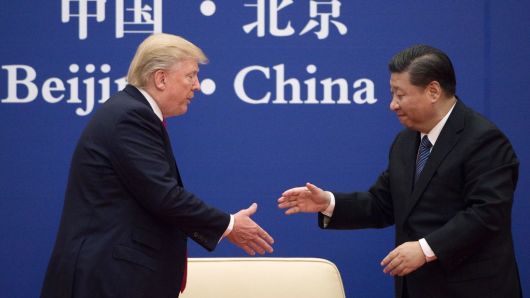
The U.S. and China just can’t seem to bridge their differences on trade, even as the world’s largest economy’s discussions with Europe and its North American neighbors appear to be making progress.
This week, President Donald Trump stood side by side with European Commission President Jean-Claude Juncker to announce talks and a truce on tariffs. The administration also met with Mexican negotiators, and officials are planning more talks aimed at wrapping up a deal for a revised North American Free Trade Agreement (NAFTA) by September.
But when it comes to China, there are no talks underway. Within the next few days, the U.S. is expected to release a final list of another $16 billion of Chinese goods that will subject to a 25 percent tariff, and China is expected to retaliate in kind. These tariffs are part of a bigger, $50 billion package that had been put in place earlier this month.
Washington has sent several signals this past week that the stalemate with Beijing won’t be resolved quickly. Top White House economic advisor Larry Kudlow told reporters to look for discussions to bear fruit in the next “six to 12 months.”
Treasury Secretary Steven Mnuchin suggested China still had yet to make the type of qualitative offer that would satisfy the president. “There continue to be some quiet conversations, but we’re prepared if they’re going to make serious moves to negotiate,” he said.
China’s message, meanwhile, has not been subtle. Just after Trump stood in the Rose Garden with Juncker Wednesday, U.S. chipmaker Qualcomm revealed that a plan to buy NXP Semiconductors for $43 billion had become a casualty of the trade war. The deal died as the deadline expired without China approving it, and analysts see no immediate end in sight to the impasse.
“The U.S. has no incentive to do this until after midterms. China has no incentive to do this until after the midterms,” noted Daniel Clifton, head of policy research at Strategas Research.
“That’s why months and months is probably a better case. Could there be an event that pushes this forward? Both parties would need something big to change,” he added.
‘Very disappointed’
While there are promising signs with Europe and NAFTA, the failure of the Qualcomm deal is symbolic of core issues with China. The U.S believes the relationship is on a one-way street to benefit from American technology while China limits access to its own market.
Mnuchin said he had personally spoken to Chinese officials about Qualcomm, but they still did not grant approval for the deal. “I’m very disappointed they didn’t get regulatory approval. I specifically had conversations. Unfortunately, I think this is another example of where it was approved in every single other territory. We’re just looking for U.S. companies to be treated fairly,” Mnuchin told CNBC’s “Squawk Box.”
China’s inaction on Qualcomm was seen as a chilling signal for other deals. But it also may have impacted the fate of ZTE, the Chinese communications that was banned by the Commerce Department from buying American products this year because it violated U.S. sanctions. The administration was trying to lift penalties on the company to smooth relations with Beijing.
Congress is expected to pass a defense bill that would allow ZTE to acquire some U.S. components. However, Clifton said some senators suggested they may seek to put new limits on the company later on.
“What it’s done is it’s changed the appetite toward ZTE so some senators who were reluctant to put ZTE out of business are now starting to take an interest in maybe including that provision in another piece of must-pass legislation later on,” said Clifton.
The progress in talks with Europe also comes as Congress has become more adamant about the collateral damage from Trump’s trade tactics — including the hit to farmers that the administration tried to soothe this week with a $12 billion USDA bailout package.
Companies like General Motors and other automakers, are making it clear that costs are rising as a result of tariffs. Meanwhile, business lobbies have sought to stop further tariffs, particularly on automobiles, which could have a wider, more significant impact on the economy and jobs.
Trump is clearly concerned about the economic pain from tariffs, and analysts say it is clear he needs a win on the trade front. As a result, they expect the U.S. may show more flexibility on NAFTA and with Europe.
The president, while standing with Juncker, also made a point of discussing how Europe has agreed to buy U.S. liquefied natural gas and soybeans, a crop that could be hit hard by tariffs already imposed by China. Trump also agreed to hold off on all tariffs on European goods for now: Those include autos, which was seen as one the most economically damaging proposals he has made for industry and consumers.
“I’m sure they’re also feeling a lot of pressure from the news that we had recently about the beef producers and the ag producers,” said Juan Carlos Hartasanchez, senior director at Albright Stonebridge, referring to reports of U.S. beef piling up in cold storage.
“When you have to put together a bailout package for your producers because of the impact of your trade negations had, I think that’s the moment when the administration steps back and thinks … ‘These things are having an effect on U.S. jobs and on the U.S. economy,'” he said. ”
For them it’s also a way to say we’re making progress. We’re not only losing, we’re also winning,” Hartasanchez added.
But if the U.S. economy starts to suffer from the trade dispute with China, Strategas ‘ Clifton said that would motivate Trump to restart talks. In the case of China, it too might come to the table sooner, if it suddenly appears as though Republicans would make a strong showing in the November mid-terms, retaining both houses of Congress, he said.
The U.S. has so far slapped tariffs on $50 billion worth of Chinese products, and aluminum and steel. China has taken similar actions on U.S. goods. Tariffs on the first $34 billion of the $50 billion went into effect earlier this month by both countries, with the rest yet to be implemented.
However, there are bigger threats in the balance, with Trump proposing $200 billion more in an effort to get China to ease its position on U.S. intellectual property and tariffs.Clifton said that revamping the World Trade Organization (WTO) would be an important step that could resolve some U.S. concerns.
“The WTO reform is the essence of what Trump is trying to fix with China,” said Clifton. China is the world’s second-largest economy, but is considered a developing nation, a status that gives them more leeway to impose trade restrictions, the analyst explained.
“They’re allowed to have tariffs on average of 9 percent,” Clifton added, while a developed country would only be able to have tariffs in low single digits.
Separately, Trump has “gotten buy in from Europe that maybe the World Trade Organization needs to be reformed. … If we’re reforming the WTO, we’re doing it to make China play by a better system of rules,” he said.
Meanwhile, Canada on Friday said it plans to host a meeting of trade ministers to discuss how to reform the WTO, but it left the U.S. and China out of the meetings for now. A spokesman for Canadian trade minister Jim Carr said the meeting would take place in Ottawa in October, and invitees include Japan, the European Union, Mexico, South Korea, Australia, Brazil, Chile, Norway, New Zealand, Switzerland, Kenya and Singapore.
Deals, deals, deals
Albright Stonebridge’s Hartasanchez said the Trump administration could be compelled to move, given that many of the U.S.’s trading partners are negotiating with one another without America in the mix. For example, Canada and Mexico are also part of the Trans-Pacific Trade Partnership, which Trump exited.
“They’re starting to see the world moving without the U.S., and I think that’s alarming when they look at the aggregate of these markets without the U.S.,” he said. “You could see the change in tone, but I think it could be a tone that could change in less than a week. But at least one has to be optimistic about the change of tone with the European visit and NAFTA.”
Hartasanchez, who follows NAFTA, said there was still disagreement over the sunset provision, which the U.S. has been pushing, and a provision on how conflicts would be resolved. Canada has pushed to retain the resolution of trade conflicts by NAFTA members. If dropped, it could instead drive disputes into courts, something opposed by many U.S. companies.
The U.S. and Mexico had been having bilateral discussions, and the U.S. said it could do separate deals with Mexico and Canada. But on Wednesday, Mexican and Canadian officials said they wanted to work toward a trilateral deal, and were not interested in bilateral agreements with the U.S. On Thursday, Mnuchin said the administration was “indifferent” to bilateral or trilateral agreements.























